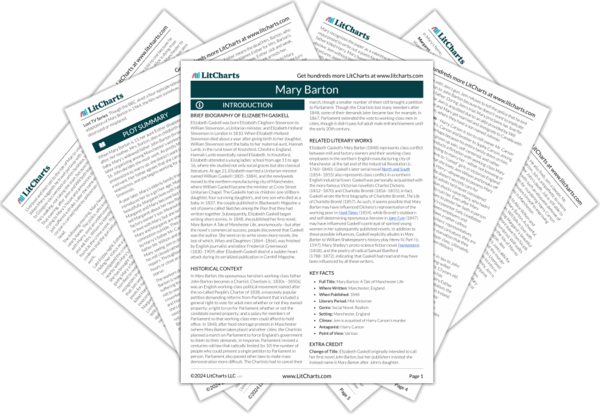Mary Barton represents poor people as more likely to act in moral ways than rich people—not because poor people have inherently better moral instincts, but because they are more likely to encounter, recognize, and thus react to others’ needs. Throughout the novel, working-class characters see one another in distress and respond by giving generous aid. For instance, Margaret, a working-class girl with worsening cataracts, sews mourning clothes for an impoverished new widow for free even though the work hurts her eyes. Similarly, factory worker John Barton pawns his few valuables to buy food for his sick former coworker’s starving children. Another example is Mrs. Sturgis, a boatman’s wife who offers Mary Barton a bed for the night despite suspecting (in a disapproving way) she’s a sex worker. Over and over, then, poor and working-class characters help one another as a matter of course. By contrast, rich characters who are removed from regular contact with the needy assume that they can do nothing to help—and so they do nothing. For example, factory owner Mr. Carson assumes and explicitly argues that he can’t help his workers during economic downturns because he doesn’t control the demand for goods and thus for labor; he never considers that he could simply and directly give the starving working-class families around him his own food or money, the way these families share food or money with each other whenever possible. Thus, Mary Barton argues that poor people are likely to perform more good deeds than rich people simply because they have more social contact with their needy neighbors and, as a result, see their neighbors’ problems as practical, solvable issues.
Poverty and Morality ThemeTracker

Poverty and Morality Quotes in Mary Barton
“I tell you it’s the poor, and the poor only, as does such things for the poor. Don’t think to come over me with th’ old tale that the rich know nothing of the trials of the poor; I say, if they don’t know, they ought to know.”
“Don ye think He’s the masters’ Father, too? I’d be loth to have ‘em for brothers.”
“Eh, John! donna talk so; sure there’s many and many a master as good or better nor us.”
“If you think so, tell me this. How comes it they’re rich, and we’re poor? I’d like to know that. Han they done as they’d be done by for us?”
“How can I keep her from being such a one as I am; such a wretched, loathsome creature! She was listening just as I listened, and loving just as I loved, and the end will be just like my end. How shall I save her?”
The eyes of John Barton grew dim with tears. Rich and poor, masters and men, were then brothers in the deep suffering of the heart; for was not this the very anguish he had felt for little Tom, in years so long gone by that they seemed like another life!
To those who have large capability of loving and suffering, united with great power of firm endurance, there comes a time in their woe when they are lifted out of the contemplation of their individual case into a searching inquiry into the nature of their calamity, and the remedy (if remedy there be) which may prevent its recurrence to others as well as themselves.











